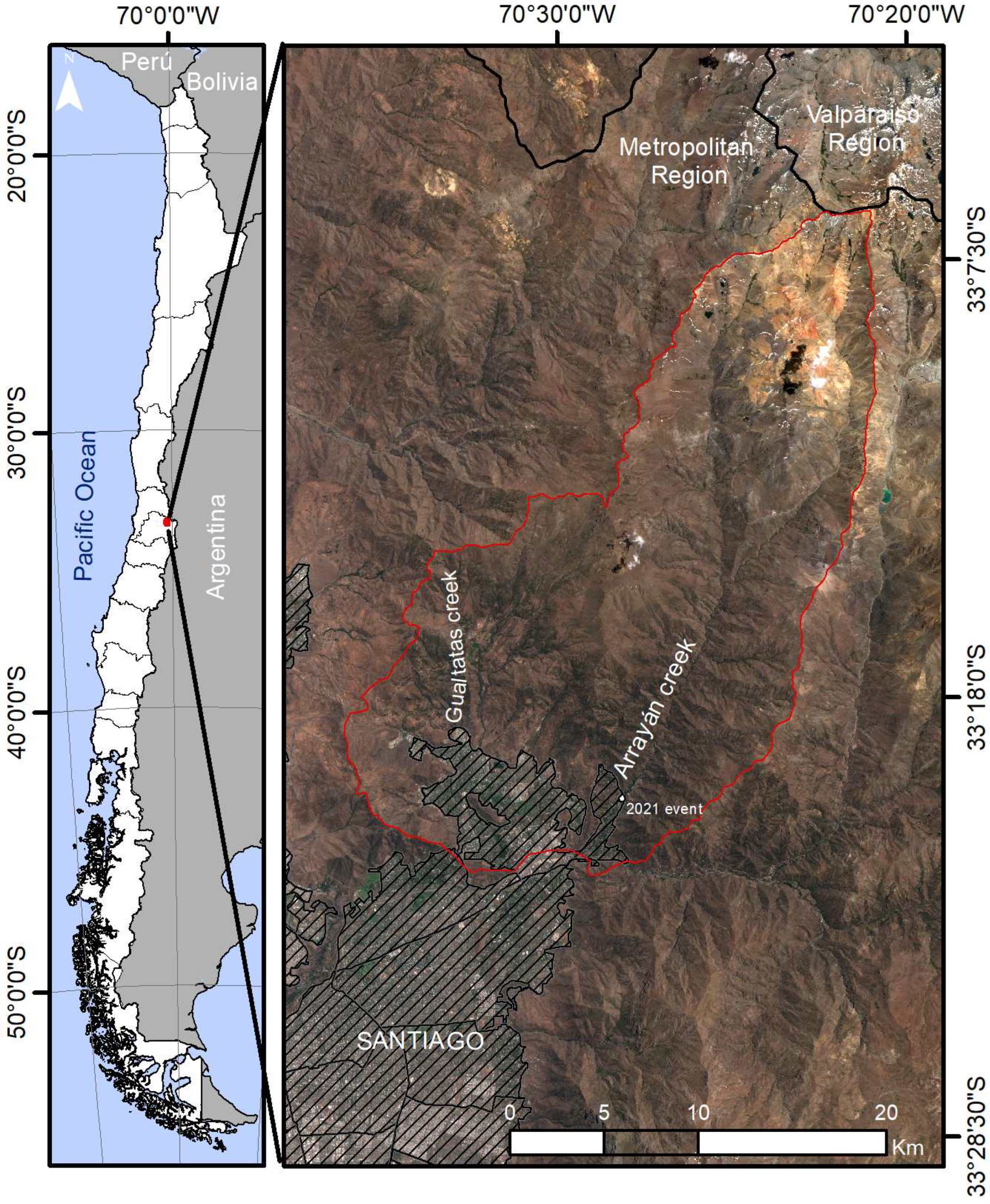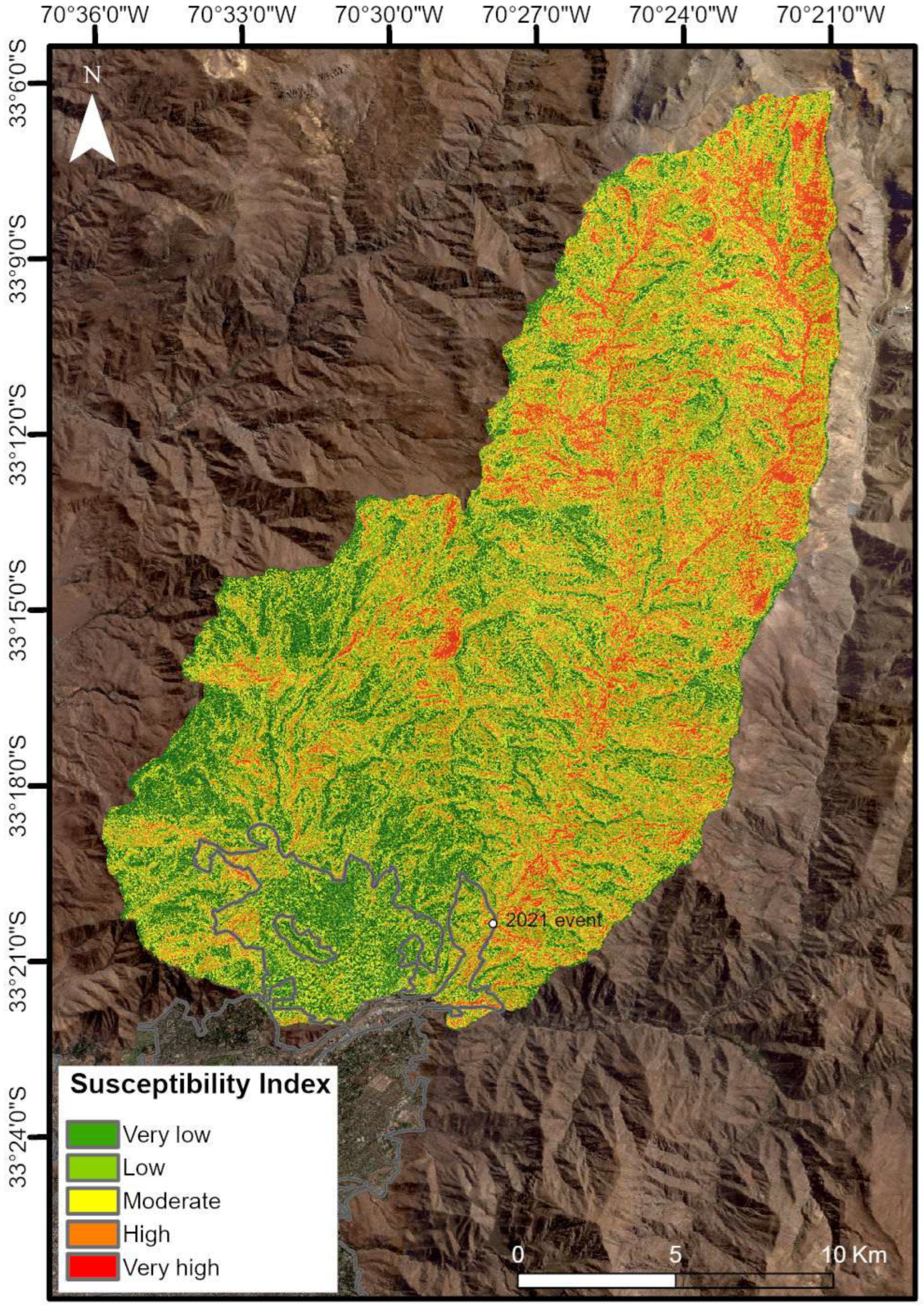Remote Sensing and GIS Data Applied to Debris Flow and Debris Flood Susceptibility in the Northeastern Sector of the City of Santiago †
Abstract
1. Introduction
2. Material and Methods
2.1. Study Area
2.2. Data Sources
2.3. Conditioning Factors
2.4. Susceptibility
3. Results
4. Conclusions
Author Contributions
Funding
Institutional Review Board Statement
Informed Consent Statement
Data Availability Statement
Conflicts of Interest
References
- Lara, M.; Sepúlveda, S.A. Landslide susceptibility and hazard assessment in San Ramón Ravine, Santiago de Chile, from an engineering geological approach. Environ. Earth Sci. 2010, 60, 1227–1243. [Google Scholar] [CrossRef]
- Lara, M.; Sepúlveda, S.A.; Celis, C.; Rebolledo, S.; Ceballos, P. Landslide susceptibility maps of Santiago city Andean foothills, Chile. Andean Geol. 2018, 45, 433–442. [Google Scholar] [CrossRef]
- Lambiel, C.; Maillard, B.; Kummert, M.; Reynard, E. Geomorphology of the hérens valley (Swiss alps). J. Maps 2016, 12, 160–172. [Google Scholar] [CrossRef]
- Hungr, O.; Leroueil, S.; Picarelli, L. The Varnes classification of landslide types, an update. Landslides 2014, 11, 167–194. [Google Scholar] [CrossRef]
- Varnes, D.J. Slope movement types and processes. Spec. Rep. 1978, 176, 11–33. [Google Scholar]
- Sepúlveda, S.A.; Moreiras, S.M.; Lara, M.; Alfaro, A. Debris flows in the Andean ranges of central Chile and Argentina triggered by 2013 summer storms: Characteristics and consequences. Landslides 2015, 12, 115–133. [Google Scholar] [CrossRef]
- Lomnitz, C. Los terremotos del 4 de septiembre de 1958 en el Cajón del Maipo. An. De La Fac. De Cienc. Físicas Y Matemáticas 1961, 18, 275–294. [Google Scholar]
- Valenzuela, L.; Varela, J. El Alfalfal rock fall and debris flow in Chilean Andes mountain. In Proceedings of the 9th Panamerican Conference on Soil Mechanics and Foundation Engineering, Viña del Mar, Chile, 26–30 August 1991; Volume 1, pp. 357–371. [Google Scholar]
- Naranjo, J.A.; Varela, J. Flujos de detritos y barro que afectaron el sector oriente de Santiago, el 3 de mayo de 1993. Serv. Nac. Geol. Y Minería 1996, 47, 42. [Google Scholar]
- Sepúlveda, S.A.; Rebolledo, S.; Vargas, G. Recent catastrophic debris flows in Chile: Geological hazard, climatic relationships and human response. Quat. Int. 2006, 158, 83–95. [Google Scholar] [CrossRef]
- SERNAGEOMIN. Principales Desastres Ocurridos Desde 1980 en Chile; Servicio Nacional de Geología y Minería, Oficina de Comunicaciones: Santiago, Chile, 2017; p. 45. [Google Scholar]
- Hauser, A. Flujos de Barro en la Zona Preandina de la Región Metropolitana: Características, Causas, Efectos, Riesgos y Medidas Preventivas; Revista geológica de Chile: Santiago, Chile, 1985; Volume 24. [Google Scholar]
- Hauser, A. Informe Geotécnico Flujos Detríticos en Quebrada Las Amarillas, Sector Baños Morales, Región Metropolitana; unpublished report; Servicio Nacional de Geología y Minería: Santiago, Chile, 1991. [Google Scholar]
- Hauser, A. Informe Geotécnico Referido a la Evaluación de Riesgos de Remociones en Masa, Sector Villa del Valle, Baños Morales, Región Metropolitana; unpublished report; Servicio Nacional de Geología y Minería: Santiago, Chile, 1993. [Google Scholar]
- Hauser, A. Geología, Geotecnia y Evaluación de Riesgo Aluvional en Torno a la Localidad de Sal Alfonso, Región Metropolitana; unpublished report; Servicio Nacional de Geología y Minería: Santiago, Chile, 1996. [Google Scholar]
- Gajardo, A.; Garrido, N.; Falcón, F. Reconocimiento Geológico de Los Eventos de Remoción en Masa Ocurridos el 21 de Enero de 2013 en el Cajón del Maipo, Región Metropolitana; unpublished report; Servicio Nacional de Geología y Minería: Santiago, Chile, 2013. [Google Scholar]
- CR2. Análisis: Una Tormenta de Invierno en Pleno Verano? Entendiendo el Extraordinario Evento de Finales de Enero de 2021 en Chile Central. Center for Climate and Resilience Research 2021. Available online: https://www.cr2.cl/analisis-una-tormenta-de-invierno-en-pleno-verano-entendiendo-el-extraordinario-evento-de-finales-de-enero-de-2021-en-chile-central-cr2 (accessed on 21 November 2023).
- Anglo American. Minuta Flujo de Detritos Sector la Lata Cuenca del Estero Yerba Loca; unpublished report; Anglo American: London, UK, 2023. [Google Scholar]
- Reichenbach, P.; Rossi, M.; Malamud, B.D.; Mihir, M.; Guzzetti, F. A review of statistically-based landslide susceptibility models. Earth-Sci. Rev. 2018, 180, 60–91. [Google Scholar] [CrossRef]
- Viale, M.; Garreaud, R. Orographic effects of the subtropical and extratropical Andes on upwind precipitating clouds: Effects of the Andes on precipitation. J. Geophys. Res. Atmos. 2015, 120, 4962–4974. [Google Scholar] [CrossRef]
- Muñoz-Sáez, C.; Pinto, L.; Charrier, R.; Nalpas, T. Influence of depositional load on the development of a shortcut fault system during the inversión of an extensional basin: The Eocene-Oligocene Abanico Basin case, central Chile Andes (33°–35° S). Andean Geol. 2014, 41, 1–28. [Google Scholar] [CrossRef]
- DGA. Inventario Público de Glaciares de Chile. Dirección General de Aguas, Ministerios de Obras Públicas, Gobierno de Chile. 2022. Available online: https://dga.mop.gob.cl/inventario-publico-de-glaciares-actualizacion-2022/ (accessed on 29 May 2025).
- Saavedra, F.A.; Kampf, S.K.; Fassnacht, S.R.; Sibold, J.S. Changes in Andes snow cover from MODIS data, 2000–2016. Cryosphere 2018, 12, 1027–1046. [Google Scholar] [CrossRef]
- Lara, M. Metodología Para la Evaluación y Zonificación de Peligro de Remociones en Masa con Aplicación en Quebrada San Ramón, Santiago Oriente, Región Metropolitana. Master’s Thesis, Mención Geología, Universidad de Chile, Departamento de Geología, Santiago, Chile, 2007; p. 229. [Google Scholar]
- Wubalem, A. Landslide susceptibility mapping using statistical methods in Uatzau catchment area, northwestern Ethiopia. Geoenviron. Disasters 2021, 8. [Google Scholar] [CrossRef]
- Droguett, B.; Vidal-Páez, P.; Clavero, J.; Pérez-Martínez, W.; Briceño-De-Urbaneja, I.; Ramírez, V.; Tamayo, A. Heavy rain-induced debris flow/flood hazards at a geomorphologically active Andean valley: The case of the Yerba Loca basin, Central Chile. Andean Geol. 2023; review paper. [Google Scholar]
- Nohani, E.; Moharrami, M.; Sharafi, S.; Khosravi, K.; Pradhan, B.; Pham, B.T.; Lee, S.; Melesse, A.M. Landslide Susceptibility Mapping Using Different GIS-Based Bivariate Models. Water 2019, 11, 1402. [Google Scholar] [CrossRef]
- Regmi, A.D.; Devkota, K.C.; Yoshida, K.; Pradhan, B.; Pourghasemi, H.R.; Kumamoto, T.; Akgun, A. Application of frequency ratio, statistical index, and weights of evidence model sand their comparison in landslide susceptibility mapping in Central Nepal Himalaya. Arab. J. Geosci. 2014, 7, 725–742. [Google Scholar] [CrossRef]
- Pérez-Martínez, W.; Pardo-Pascual, J.E.; Briceño, I.; Vidal, P. Study of Natural Hazards in the Upper Part of the Mapocho River Basin, Metropolitan Region of Chile, Using Satellite Imagery. Proceedings 2019, 19, 4. [Google Scholar] [CrossRef]
- Abedin, J.; Rabby, Y.W.; Hasan, I.; Akter, H. An investigation of the characteristics, causes, and consequences of June 13, 2017, landslides in Rangamati District Bangladesh. Geoenviron. Disasters 2020, 7, 23. [Google Scholar] [CrossRef]
- Hansen, M.C.; Potapov, P.V.; Moore, R.; Hancher, M.; Turubanova, S.A.; Tyukavina, A.; Thau, D.; Stehman, S.V.; Goetz, S.J.; Loveland, T.R.; et al. High-Resolution Global Maps of 21st-Century Forest Cover Change. Science 2013, 342, 850–853. [Google Scholar] [CrossRef] [PubMed]
- Aleotti, P.; Chowdhury, R. Landslide hazard assessment: Summary review and new perspectives. Bull. Eng. Geol. Environ. 1999, 58, 21–44. [Google Scholar] [CrossRef]
- Vidal-Páez, P.; Clavero, J.; Droguett, D.; Pérez-Martínez, W.; Briceño-De-Urbaneja, I.; Oliva, P. Landslide Susceptibility Using Remote Sensing Data & GIS in a High Andean Area of Central Chile. In Proceedings of the IGARSS 2020-2020 IEEE International Geoscience and Remote Sensing Symposium, Waikoloa, HI, USA, 17 February 2020; pp. 6604–6607. [Google Scholar] [CrossRef]
- Intarawichian, N.; Dasananda, S. Analytical Hierarchy Process for Landslide Susceptibility Mapping in Lower Mae Chaem Watershed, Northern Thailand. Suranaree J. Sci. Technol. 2010, 17, 277–292. [Google Scholar]
- Saaty, T.L.; Vargas, L.G. Models, Methods, concepts & applications of the analytic hierarchy process. In International Series in Management Science/Operations Research; Springer: Berlin/Heidelberg, Germany, 2012. [Google Scholar] [CrossRef]
- Jenks, G.F.; Caspall, F.C. Error on choroplethic maps: Definition, measurement, reduction. Ann. Assoc. Am. Geogr. 1971, 61, 217–244. [Google Scholar] [CrossRef]


| Group | Subgroup | Percentage |
|---|---|---|
| Geomorphology | Topography | 41% |
| Geoforms | 7% | |
| Drainage | 26% | |
| Geology | Units | 11% |
| Structures | 6% | |
| Soil Condition | Forestation | 3% |
| Coverage | 3% | |
| Snow | 3% |
| Susceptibility Index | Susceptibility |
|---|---|
| <1.51 | Very Low |
| 1.51–1.79 | Low |
| 1.79–2.05 | Moderate |
| 2.05–2.33 | High |
| 2.33–3.55 | Very High |
| Susceptibility | Area (km2) | Percentage |
|---|---|---|
| Very Low | 59.63 | 15.93% |
| Low | 97.55 | 26.06% |
| Moderate | 105 | 28.06% |
| High | 80.64 | 21.54% |
| Very High | 31.43 | 8.39% |
Disclaimer/Publisher’s Note: The statements, opinions and data contained in all publications are solely those of the individual author(s) and contributor(s) and not of MDPI and/or the editor(s). MDPI and/or the editor(s) disclaim responsibility for any injury to people or property resulting from any ideas, methods, instructions or products referred to in the content. |
© 2025 by the authors. Licensee MDPI, Basel, Switzerland. This article is an open access article distributed under the terms and conditions of the Creative Commons Attribution (CC BY) license (https://creativecommons.org/licenses/by/4.0/).
Share and Cite
Castro-Cancino, B.; Pérez-Martínez, W.; Vidal-Páez, P.; Jaña-Sepúlveda, A. Remote Sensing and GIS Data Applied to Debris Flow and Debris Flood Susceptibility in the Northeastern Sector of the City of Santiago. Eng. Proc. 2025, 94, 23. https://doi.org/10.3390/engproc2025094023
Castro-Cancino B, Pérez-Martínez W, Vidal-Páez P, Jaña-Sepúlveda A. Remote Sensing and GIS Data Applied to Debris Flow and Debris Flood Susceptibility in the Northeastern Sector of the City of Santiago. Engineering Proceedings. 2025; 94(1):23. https://doi.org/10.3390/engproc2025094023
Chicago/Turabian StyleCastro-Cancino, Benjamín, Waldo Pérez-Martínez, Paulina Vidal-Páez, and Allison Jaña-Sepúlveda. 2025. "Remote Sensing and GIS Data Applied to Debris Flow and Debris Flood Susceptibility in the Northeastern Sector of the City of Santiago" Engineering Proceedings 94, no. 1: 23. https://doi.org/10.3390/engproc2025094023
APA StyleCastro-Cancino, B., Pérez-Martínez, W., Vidal-Páez, P., & Jaña-Sepúlveda, A. (2025). Remote Sensing and GIS Data Applied to Debris Flow and Debris Flood Susceptibility in the Northeastern Sector of the City of Santiago. Engineering Proceedings, 94(1), 23. https://doi.org/10.3390/engproc2025094023






